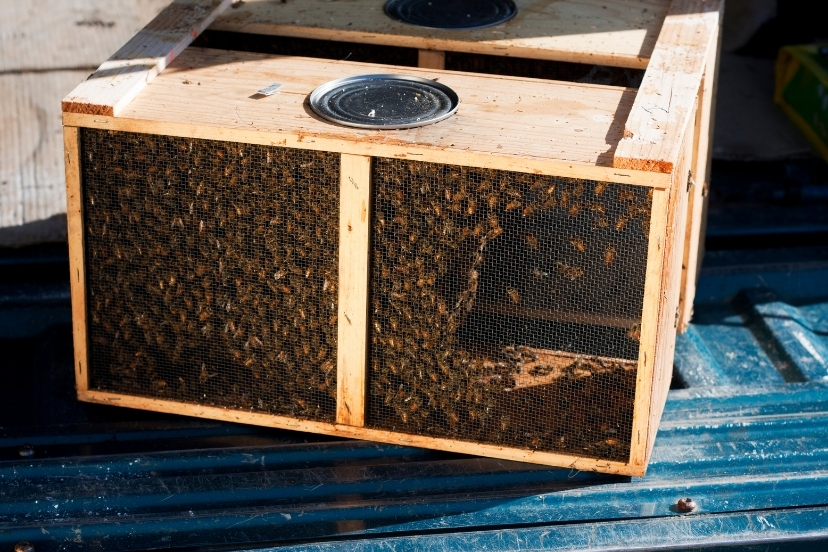An EpiPen (or Epi-Pen) is designed to provide a self-administered emergency treatment for anaphylactic shock. You must have a prescription to purchase one. This article is intended for informational purposes and is not medical advice or a substitute for getting professional medical attention.
How it Works
If you experience a life-threatening allergic reaction from a bee sting (or any other cause), prompt treatment is crucial. Survival may depend upon receiving treatment within minutes.
 If you can’t get to a doctor quickly, though, you can treat yourself by simply removing a cap and safety release, and jabbing the device against your thigh.
If you can’t get to a doctor quickly, though, you can treat yourself by simply removing a cap and safety release, and jabbing the device against your thigh.
The force of jabbing the device against your thigh causes a dose of epinephrine to be injected into your bloodstream automatically using an auto-injector.
You do not have to depress a syringe, or meter the amount of medicine being injected. The syringe automatically injects the proper amount of epinephrine.
Frequently Asked Questions
What is an epipen?
An epipen is a device that is used to deliver a measured dose of epinephrine (also known as adrenaline) to a person who is experiencing a severe allergic reaction. The epipen is designed to be used in an emergency situation where there is no time to waste in getting the person the medical help they need.
What is the active ingredient?
The active ingredient in an EpiPen is epinephrine, also known as adrenaline. Epinephrine is a hormone that is released by the adrenal glands in response to stress.
It increases heart rate and blood pressure and constricts blood vessels. It also increases blood sugar levels and has a calming effect.
How does an epipen work?
An epipen is a device that is used to inject a measured dose of epinephrine (also known as adrenaline) into the body.
Epinephrine is a hormone that is released by the body in response to stress, and it has a number of effects on the body, including increasing heart rate and blood pressure, and opening up the airways.
Epinephrine is also used as a medication to treat a number of conditions, including allergies, asthma, and heart failure.
What are the indications for using one?
There are a few different indications for using an epipen. The most common one is if you have an allergy to a particular substance, and you are exposed to that substance.
If you start having difficulty breathing, or your throat starts to swell, you would use your epipen. Another indication for using an epipen is if you are having an anaphylactic reaction to something.
How do you use it?
If you are allergic to a bee sting, you will need to use an epipen. The epipen is a device that injects a dose of epinephrine (also known as adrenaline) into your body. This will help to counteract the allergic reaction and will allow you to breathe more easily.
To use the epipen, you will need to remove the cap and then place the tip of the device against your thigh.
What are the possible side effects of using an epipen?
The possible side effects are:
Anaphylaxis: This is a severe and potentially life-threatening allergic reaction that can occur after using an epipen. Symptoms include swelling of the face, throat, and tongue; difficulty breathing; and a drop in blood pressure. If you experience any of these symptoms, seek medical attention immediately.
What should you do if you accidentally use it?
If you have been prescribed an epinephrine auto-injector (commonly referred to as an EpiPen®), it is important to keep it with you at all times. You never know when you or someone you care for may have a severe allergic reaction. In the event of an accidental injection, immediately call 911 for medical help and assistance.
Do not try to remove the needle from the injection site as this can cause more tissue damage.
Can an epipen be reused?
No, an epipen cannot be reused. Epipens are designed for single use only and should be disposed of after each use. Reusing an epipen can result in decreased effectiveness and potentially dangerous side effects.
What are the bee species that are most likely to cause anaphylaxis?
There are a number of bee species that are most likely to cause anaphylaxis. These include the honey bee, the bumble bee, and the Africanized honey bee. Each of these bee species has a venom that can cause an allergic reaction in some people.
The honey bee is the most common bee species that causes anaphylaxis. This is because the honey bee’s venom is more potent than the venom of other bee species.
How does an epipen work for bee stings?
When you are stung by a bee, the bee injects a small amount of venom into your skin. The venom causes your body to have an allergic reaction, and your blood pressure to drop.
The epipen works by injecting a small amount of epinephrine (adrenaline) into your body. The epinephrine helps to reverse the effects of the venom, and it also helps to raise your blood pressure.
Who developed epinephrine?
Epinephrine was first isolated in 1894 by Japanese researcher Jokichi Takamine, who was working on a way to purify the hormone adrenaline. He named the compound epinephrine, from the Greek words for “over” and “nerve,” because it increased blood pressure and heart rate.
In 1901, another Japanese researcher, Nagai Nagayoshi, discovered that epinephrine could be used to treat asthma.
Who conducted the first clinical trials of epinephrine for bee sting treatment?
In the early 1900s, a physician named Charles Richet began experimenting with epinephrine as a possible treatment for anaphylaxis, a severe and potentially life-threatening allergic reaction. Richet injected epinephrine into himself and a few volunteers, and found that it helped to relieve the symptoms of anaphylaxis.
In 1901, Richet published his findings in the medical journal The Lancet.
What is the difference between an epipen and a bee sting?
An epipen is a device that is used to inject a person with epinephrine. Epinephrine is a hormone that is released by the body in response to a perceived threat. It is also known as adrenaline.
Bee stings, on the other hand, are the result of a bee injecting venom into a person. Bee venom is a mixture of proteins and other chemicals that can cause a variety of reactions in humans, ranging from mild to life-threatening.


